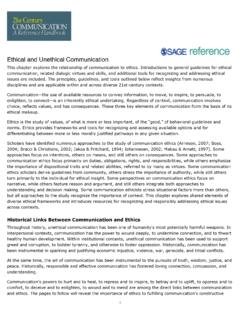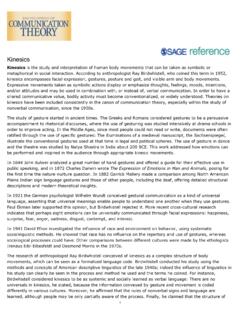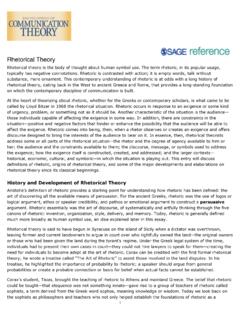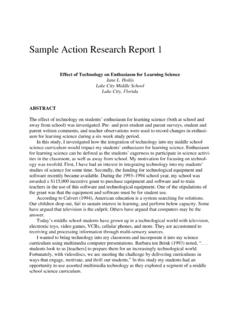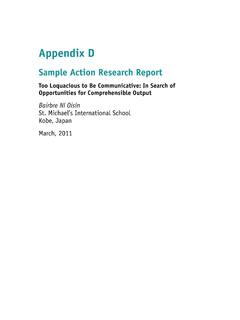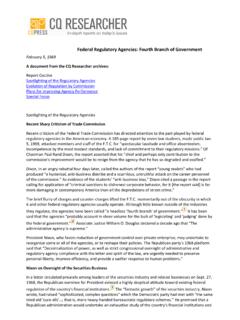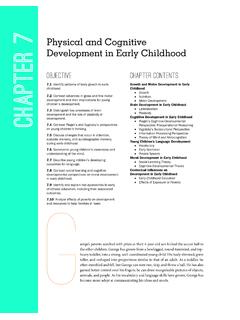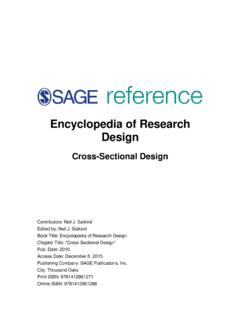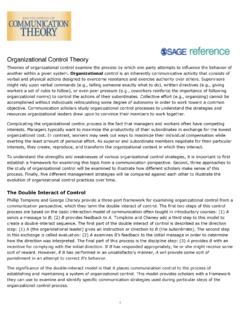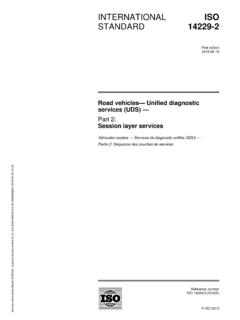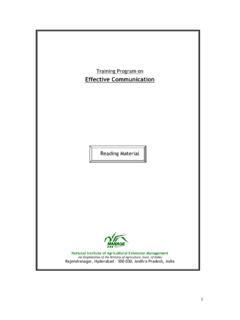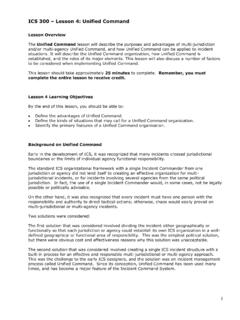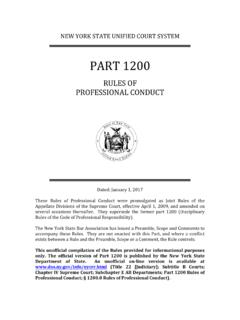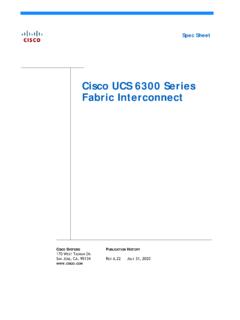Transcription of Functional Group Communication Theory : Encyclopedia of ...
1 Functional Group Communication TheoryThe Functional Group Communication Theory is a unified and coherent set of propositions, assumptions, andclaims that attempt to explain how and why Communication is related to the quality of the decisions groupsmake. The Theory has been very influential in guiding researchers' and practitioners' views about howcommunication affects Group decision making and how Communication might be structured to increase thelikelihood that groups will arrive at high-quality and InfluencesDennis Gouran and Randy Hirokawa are the researchers most closely associated with the Functional Theory ofeffective Group decision making.
2 They state that the origins of the Theory lie in three influences: the work ofJohn Dewey and his work on reflective thinking, Robert Bales and his work on interaction process analysis, andIrving Janis and his work on vigilant decision the early part of the 20th century, John Dewey developed a method to describe the process thatindividuals should go through as they work on problem solving. In his 1910 book, How We Think, Deweysuggested that the process of reflective thinking involves five steps: (1) a felt difficulty, (2) its location anddefinition, (3) suggestion of possible solution, (4) development by reasoning of the implications andconsequences of the solution, and (5) further observation and experiment leading to its acceptance or second influence on the development of the Functional Theory of effective Group decision making is the workof Robert Bales.
3 Bales and his colleagues had been working on Group members' ability to deal with fourfunctional problems: adaptation, instrumental control, expression, and integration. These are problems withwhich groups must deal in order to perform effectively. Adaptation and instrumental control relate to themanagement of task concerns ( , making a decision); expression and integration relate to the management ofsocioemotional concerns ( , managing relationships). Groups strive to maintain equilibrium with regard tothese two concerns, and Group Communication is a major means of maintaining that equilibrium.
4 For Bales,work on the task serves to disturb a Group 's balance in the socioemotional dimension, and Group members mustwork to restore this balance. Group Communication , then, is both a means by which deviations from equilibriumcan be identified and a means by which equilibrium can be accomplished or restored. Bales developedinteraction process analysis (IPA) in an effort to capture how Communication functions in both the task andsocioemotional domains. IPA consists of 12 categories six related to task and six to socioemotional into whichcommunicative acts (utterances) may be third influence on the development of the Functional Theory of effective decision making is the work of IrvingJanis on vigilant decision making.
5 Janis theorized that highly cohesive groups sometimes suffer from poordecision making because of the pressures placed on their members to reach consensus. Janis labeled thiscondition groupthink. Vigilant groups (a) survey the possible alternatives-solutions available, (b) survey theobjectives to be accomplished, (c) examine the risks and benefits associated with the alternatives, (d) performan information search, (e) process the information in an unbiased manner, (f) reappraise the alternatives inlight of risks and benefits before making a final choice, and (g)
6 Work out a plan for implementing the desiredchoice along with contingency plans should additional risks associated with that choice become all three influences, the Functional nature of Communication is the focus; in other words, Communication isgoal oriented and serves to accomplish some purpose. In Dewey's reflective thinking method, Communication isfunctional because when applied to Group discussion, it is the means through which each of the steps of themethod are accomplished, thus enabling the Group to reach effective resolution of a problem.
7 Bales's IPAdenotes Communication categories that function to enable a Group to deal with equilibrium in task andsocioemotional domains. In Janis's vigilant decision making, Communication is Functional because it is themeans through which Group members fulfill each of the characteristics of TheoryThe Functional Theory of effective Group decision making rests on the assumption that decision-makingeffectiveness is not affected by the production of certain communicative behaviors per se, but by the extent towhich these fulfill the requirements for successful task completion.
8 These requirements, termed functionalrequisites, were spelled out by Gouran and Hirokawa in 1983. In order to make an effective decision, a groupshould adequately do the following:Understand the type of answer for which the issue under consideration calls. These answers are in responseto the type of question the Group is attempting to answer fact, conjecture, value, or the characteristics of an acceptable answer. Group members develop criteria that the desiredchoice should a realistic range of alternatives among which an acceptable answer is presumed to exist.
9 Groupmembers generate a broad range of possible answers/alternatives/solutions to the issue examine every alternative in relation to each criterion used to define an acceptable answer. Thisrequisite assumes skill, knowledge, and a sense of objectivity on the part of Group the alternative that best conforms to the characteristics of an acceptable answer. Group membersshould also compare the alternatives against each other to determine which appear to be the mostdesirable and a Group progresses on its path toward a given goal, Communication may influence decision making in threeways: When Communication plays a promotive role, it allows the Group to successfully accomplish the functionalrequisites.
10 When Communication plays a disruptive role, it functions to create obstacles that hinder or preventthe Group from satisfying any of the requisites for successful decision making. Finally, when communicationplays a counteractive role, it functions to negate or neutralize a communicative act that functioned as disruptiveinfluence. Thus, Communication enables a Group to resume movement along the goal path defined by therequisites of effective decision making. The Theory predicts that groups that better fulfill the requisites ofeffective decision making will make more effective , what has been found is that groups that make better decisions also produce (a) more communicativeacts fulfilling the Functional requisites, (b) acts that better fulfill the Functional requisites, and (c) acts that ratehigher on global assessments of the extent to which they accomplished the requisites.
